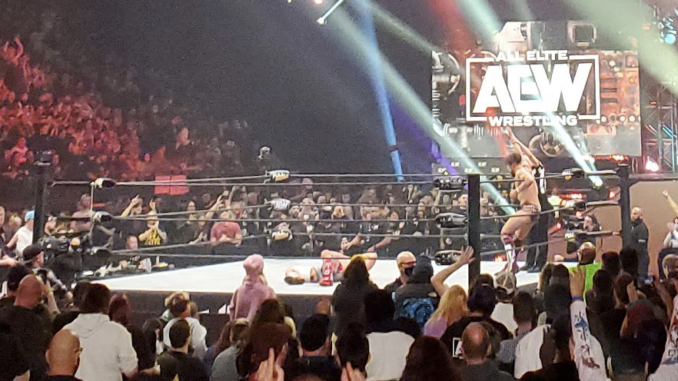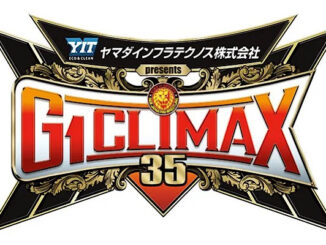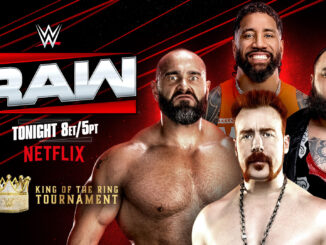
SPOTLIGHTED PODCAST ALERT (YOUR ARTICLE BEGINS A FEW INCHES DOWN)...
AEW issued a memo to wrestlers titled, “Health and Safety Protocols Relating to Matches” and it notes at the bottom that it’s “Effective July 2023.”
The memo details nine situations that are now not allowed under any circumstances. Some of them seem to indicate directly that Tony Khan has decided to move away from the type of selling that Kenny Omega and Bryan Danielson did at the recent Forbidden Door event.
The content of the memo, which Fightful first reported about and PWTorch has since obtained a copy of, follows:
NOT ALLOWED UNDER ANY CIRCUMSTANCES
- “Unprotected shots to the head” [PWTorch note: Presumably it means “chairshots”]
- “Shots to the back of the head”
- “Buckle bombs / Blind moves backward into the turnbuckle”
- “Fencing response / seizure sells” [PWTorch note: A fencing response, as defined by Very Well Health, is: “A fencing response is an involuntary physical position that occurs as a result of severe brain injury. This type of posture resembles an athletic fencing position—one arm is bent towards the body, and the other arm is outstretched. A person can experience a fencing response immediately after head trauma.“]
- “Spitting”
- “Blood in the crowd (i.e. no bleeding while in the crowd and now throwing bloody gear, tape, or other objects in the crowd)”
- “Weapons / projectiles in the crowd”
- “Taking drinks or food from guests in the crowd”
- “Physical contact with the crowd (e.g. wrestlers holding opponent and allowing a fan to chop them)”
ONLY ALLOWED IF APPROVED BY MEDICAL AND THE MATCH COACH AND MUST BE PERFORMED IN ACCORDANCE WITH ANY SAFETY PROTOCOLS
- “Spots and bumps on the ring apron and outside”
- “Table / ladder / chair spots in and out of the ring (Only allowed with padding)”
- “Any elevated spots outside of the barricade (dives and ladder spots on stage, around the arena, and other places outside of the ring)”
- “All piledriver / tombstone variations, including sit-down driver, inverted/poison hurancanrana, and vertebreaker”
- “High-risk dives or top rope moves (450, 630, double moonsault, SSP, etc.)”
- “Intentional bleeding (of any sort, not just blading)”
- “Throwing people into / through/ over ring steps, commentary table, bell table, or guardrails / barricades”
- “Weapon usage:
- Chairs, pipes, kendo sticks, hammers, ring bells, bats, chains, etc.
- Title belts
- Thumbtacks, skewers, barbed wire, and other sharp / puncturing objects
- Powders, aerosol sprays, or liquids
- Throwing any weapons or objects – chairs, etc.”
- “Choking / strangling with hands or a weapon or hanging spots””
- “Injury spots or angles, whether or not medical is involved / called to the ring”
- “Any physicality in the crowd or crowd brawling”
- “Any physicality involving referees, managers, extras, celebrities, or special guests”
It’s important to emphasize that the top section is completely outlawing some common aspects of how AEW wrestlers have told their stories during matches. The list in the second section will likely be part of AEW matches, but perhaps at a reduced level since it will take explicit clearance from key people in management for some of them to be approved.
I’ve talked with several wrestlers and others in AEW who have mixed thoughts on this. A common theme is a disbelief that this will be enforced consistently across the entire roster. Some have expressed a positive reaction to these new rules because it will force some wrestlers not to take what are perceived as “shortcuts” to earn crowd investment in matches and also stop some wrestlers from doing moves that can lead to serious injury. In addition to that, the banning of faking seizures and concussions helps avoid confusion with the medical staff whether an injury is being faked or actually needs immediate medical attention.
It’s not clear whether this new memo was prompted by several recent specific instances or if it’s part of an overall cleaning up of the AEW style with both legal liability and artistic considerations.
Kenny Omega reacted to criticism of the Tiger Driver ’91 suplex where he landed on the back of his head and neck and sold it in a way that resembled a legitimate injury instead of more traditional pro wrestling-style selling.
Did you know that PWTorch VIP membership gives you access to an ad-free version of this website (mobile and desktop versions), an unmatched 35 year library of insider wrestling content in newsletter article and podcast formats, dozens of new VIP-exclusive podcasts throughout the month (that are easily compatible with Apple Podcasts App, Apple Car Play, and many other popular podcast apps), and more benefits. Check out details and sign up HERE.
“There are people who want to complain and put themselves on a pedestal by saying what we did was dangerous.” he told Sports Illustrated. “Well, you think? So I’ve been asked, why did we do it? It made sense in the match and evoked emotion. And we both knew I would end up coming out of the move unscathed. Is there a risk? Sure. There’s always a risk… Don’t tell me not to wrestle the way I know how to wrestle. Is there a risk? Was there a risk when Mike Tyson was fighting within inches of space between another championship-level boxer throwing power punches? Of course. But Tyson was confident in his abilities, and he knew he was the best. So don’t tell Mike Tyson how to box, and don’t tell Tyson Smith how to wrestle. You aren’t even close to being qualified. Just shut the f— up.”
RECOMMENDED NEXT: CM Punk’s locker room reputation so far for AEW Collision after four weeks
OR CHECK OUT THIS PROWRESTLING.NET ARTICLE: Kenny Omega defends the Tiger Driver 91 spot from his AEW-NJPW Forbidden Door match
Subscribe to Wade Keller’s free podcasts by searching “Wade Keller” in your podcast app. They include a weekly flagship episode (blue-logo show) and the post-shows after Raw, Dynamite, Smackdown, and Rampage (red logo show) with a mix of best-of episodes too!




Leave a Reply
You must be logged in to post a comment.